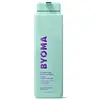What's inside
What's inside
 Key Ingredients
Key Ingredients

 Benefits
Benefits

 Concerns
Concerns

 Ingredients Side-by-side
Ingredients Side-by-side

Bakuchiol
AntimicrobialWater
Skin ConditioningCaprylhydroxamic Acid
Ethylhexyl Palmitate
EmollientGlyceryl Stearate Se
EmulsifyingCetyl Alcohol
EmollientParfum
MaskingGeraniol
PerfumingLimonene
PerfumingLinalool
PerfumingAlpha-Isomethyl Ionone
PerfumingCoumarin
PerfumingGlycerin
HumectantRicinus Communis Seed Oil
MaskingSodium Hydroxide
BufferingLactic Acid
BufferingPhenoxyethanol
PreservativeBenzyl Alcohol
PerfumingDehydroacetic Acid
PreservativeSodium Benzoate
MaskingButyrospermum Parkii Butter
Skin ConditioningEthylhexylglycerin
Skin ConditioningAvena Sativa Kernel Flour
AbrasiveBeta-Glucan
Skin ConditioningCeramide NP
Skin ConditioningCholesterol
EmollientCaprylic/Capric Triglyceride
MaskingPhytosphingosine
Skin ConditioningStearic Acid
CleansingOleic Acid
EmollientCaprylyl Glycol
EmollientAllantoin
Skin Conditioning1,2-Hexanediol
Skin ConditioningHydrogenated Lecithin
EmulsifyingCarbomer
Emulsion StabilisingBakuchiol, Water, Caprylhydroxamic Acid, Ethylhexyl Palmitate, Glyceryl Stearate Se, Cetyl Alcohol, Parfum, Geraniol, Limonene, Linalool, Alpha-Isomethyl Ionone, Coumarin, Glycerin, Ricinus Communis Seed Oil, Sodium Hydroxide, Lactic Acid, Phenoxyethanol, Benzyl Alcohol, Dehydroacetic Acid, Sodium Benzoate, Butyrospermum Parkii Butter, Ethylhexylglycerin, Avena Sativa Kernel Flour, Beta-Glucan, Ceramide NP, Cholesterol, Caprylic/Capric Triglyceride, Phytosphingosine, Stearic Acid, Oleic Acid, Caprylyl Glycol, Allantoin, 1,2-Hexanediol, Hydrogenated Lecithin, Carbomer
Water
Skin ConditioningGlycerin
HumectantSaccharide Isomerate
HumectantPropanediol
SolventAmmonium Acryloyldimethyltaurate/Vp Copolymer
Phenoxyethanol
PreservativePolyamide-5
Skin ConditioningDimethicone
EmollientHydroxyacetophenone
AntioxidantPolysilicone-11
Squalane
EmollientAloe Barbadensis Leaf Juice
Skin ConditioningLaureth-12
EmulsifyingCetearyl Olivate
Glyceryl Stearate
EmollientEthylhexylglycerin
Skin ConditioningSorbitan Olivate
EmulsifyingHelianthus Annuus Seed Oil
EmollientCetearyl Alcohol
EmollientLactobacillus Ferment
Skin ConditioningTocopherol
AntioxidantSodium Stearoyl Lactylate
EmulsifyingSodium Hyaluronate
HumectantSilybum Marianum Extract
Skin ConditioningBetula Alba Leaf Extract
AstringentBeta-Sitosterol
Emulsion StabilisingPanthenol
Skin ConditioningSqualene
EmollientCocos Nucifera Fruit Extract
EmollientCitric Acid
BufferingCamellia Sinensis Leaf Extract
AntimicrobialSodium Citrate
BufferingWater, Glycerin, Saccharide Isomerate, Propanediol, Ammonium Acryloyldimethyltaurate/Vp Copolymer, Phenoxyethanol, Polyamide-5, Dimethicone, Hydroxyacetophenone, Polysilicone-11, Squalane, Aloe Barbadensis Leaf Juice, Laureth-12, Cetearyl Olivate, Glyceryl Stearate, Ethylhexylglycerin, Sorbitan Olivate, Helianthus Annuus Seed Oil, Cetearyl Alcohol, Lactobacillus Ferment, Tocopherol, Sodium Stearoyl Lactylate, Sodium Hyaluronate, Silybum Marianum Extract, Betula Alba Leaf Extract, Beta-Sitosterol, Panthenol, Squalene, Cocos Nucifera Fruit Extract, Citric Acid, Camellia Sinensis Leaf Extract, Sodium Citrate
 Reviews
Reviews

Ingredients Explained
These ingredients are found in both products.
Ingredients higher up in an ingredient list are typically present in a larger amount.
Ethylhexylglycerin (we can't pronounce this either) is commonly used as a preservative and skin softener. It is derived from glyceryl.
You might see Ethylhexylglycerin often paired with other preservatives such as phenoxyethanol. Ethylhexylglycerin has been found to increase the effectiveness of these other preservatives.
Glycerin is already naturally found in your skin. It helps moisturize and protect your skin.
A study from 2016 found glycerin to be more effective as a humectant than AHAs and hyaluronic acid.
As a humectant, it helps the skin stay hydrated by pulling moisture to your skin. The low molecular weight of glycerin allows it to pull moisture into the deeper layers of your skin.
Hydrated skin improves your skin barrier; Your skin barrier helps protect against irritants and bacteria.
Glycerin has also been found to have antimicrobial and antiviral properties. Due to these properties, glycerin is often used in wound and burn treatments.
In cosmetics, glycerin is usually derived from plants such as soybean or palm. However, it can also be sourced from animals, such as tallow or animal fat.
This ingredient is organic, colorless, odorless, and non-toxic.
Glycerin is the name for this ingredient in American English. British English uses Glycerol/Glycerine.
Learn more about GlycerinPhenoxyethanol is a preservative that has germicide, antimicrobial, and aromatic properties. Studies show that phenoxyethanol can prevent microbial growth. By itself, it has a scent that is similar to that of a rose.
It's often used in formulations along with Caprylyl Glycol to preserve the shelf life of products.
Water. It's the most common cosmetic ingredient of all. You'll usually see it at the top of ingredient lists, meaning that it makes up the largest part of the product.
So why is it so popular? Water most often acts as a solvent - this means that it helps dissolve other ingredients into the formulation.
You'll also recognize water as that liquid we all need to stay alive. If you see this, drink a glass of water. Stay hydrated!
Learn more about Water